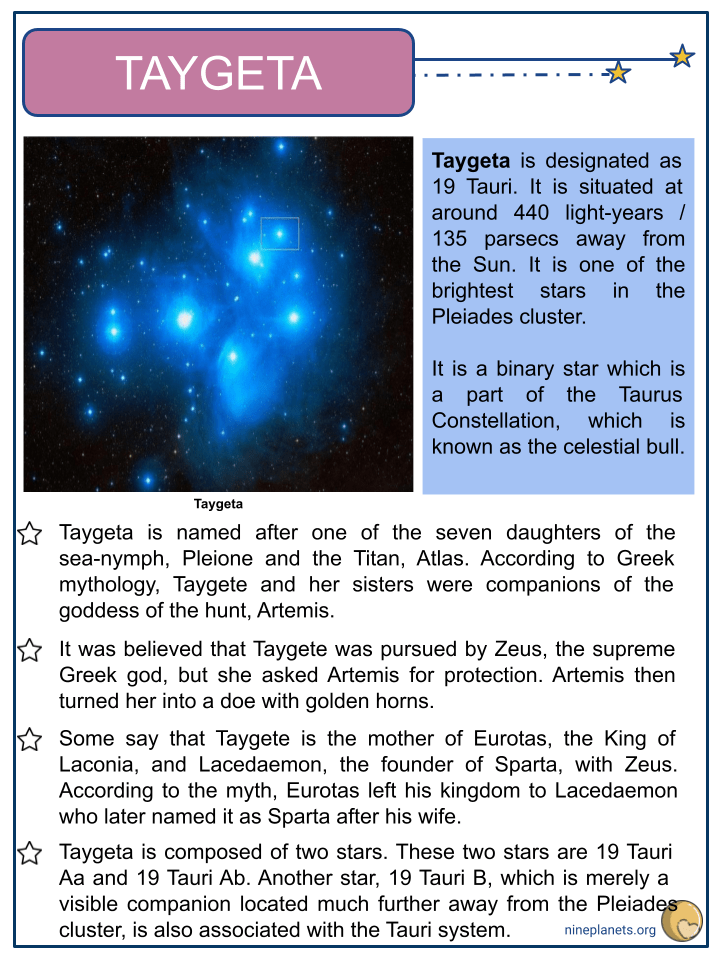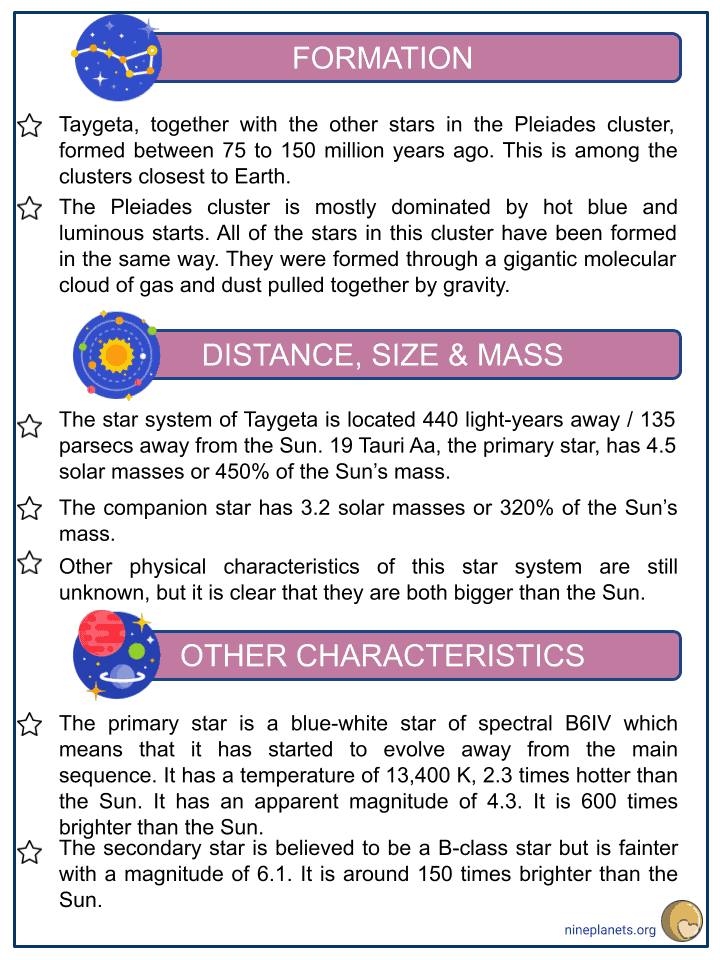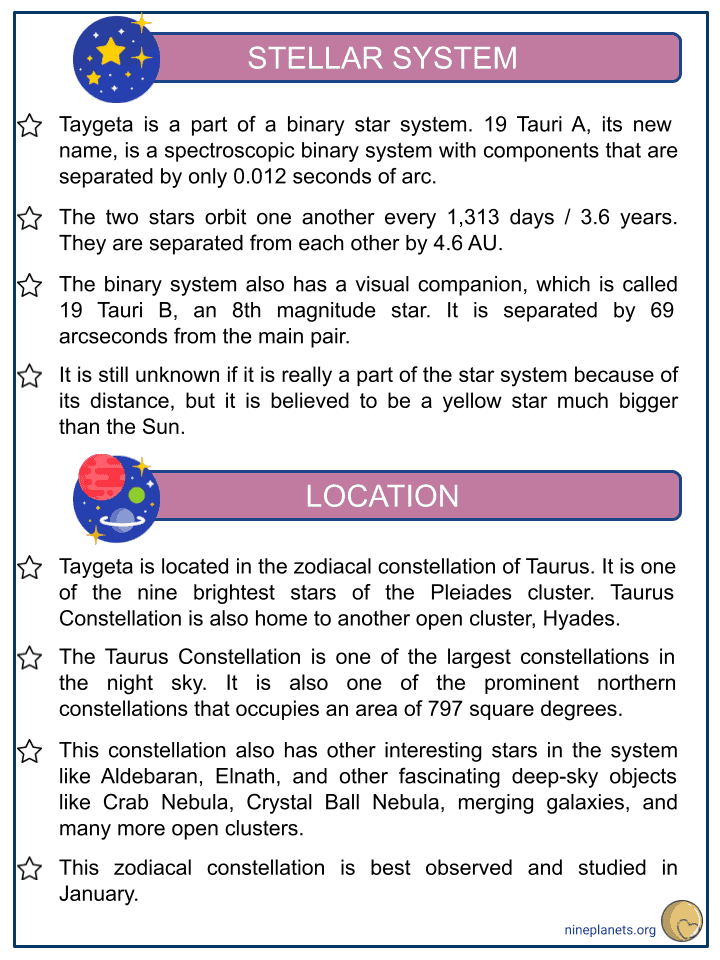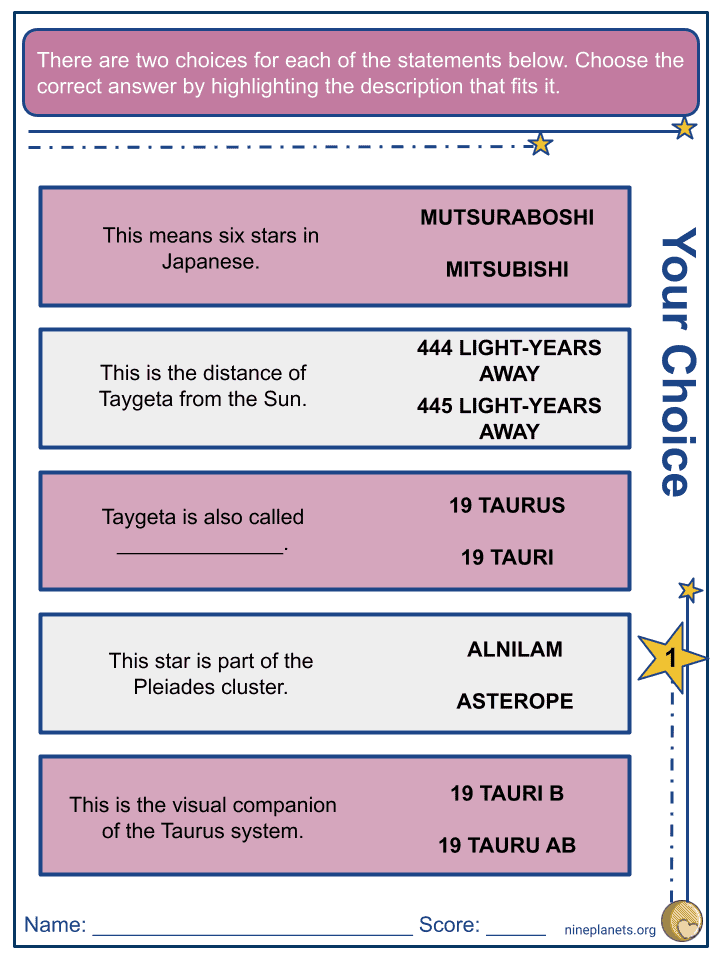Download Taygeta Worksheets
Click the button below to get instant access to these premium worksheets for use in the classroom or at a home.

This worksheet can be edited by Premium members using the free Google Slides online software. Click the Edit button above to get started.
Download free sample
Not ready to purchase a subscription yet? Click here to download a FREE sample of this worksheet pack.
Resource Examples
Click any of the example images below to view a larger version.




Key Facts & Information
- Taygeta is designated as 19 Tauri. It is situated at around 440 light-years / 135 parsecs away from the Sun. It is one of the brightest stars in the Pleiades cluster.
- It is a binary star which is a part of the Taurus Constellation, which is known as the celestial bull.
- Taygeta is named after one of the seven daughters of the sea-nymph, Pleione and the Titan, Atlas. According to Greek mythology, Taygete and her sisters were companions of the goddess of the hunt, Artemis.
- It was believed that Taygete was pursued by Zeus, the supreme Greek god, but she asked Artemis for protection. Artemis then turned her into a doe with golden horns.
- Some say that Taygete is the mother of Eurotas, the King of Laconia, and Lacedaemon, the founder of Sparta, with Zeus. According to the myth, Eurotas left his kingdom to Lacedaemon who later named it as Sparta after his wife.
- Taygeta is composed of two stars. These two stars are 19 Tauri Aa and 19 Tauri Ab. Another star, 19 Tauri B, which is merely a visible companion located much further away from the Pleiades cluster, is also associated with the Tauri system.
Formation
- Taygeta, together with the other stars in the Pleiades cluster, formed between 75 to 150 million years ago. This is among the clusters closest to Earth.
- The Pleiades cluster is mostly dominated by hot blue and luminous starts. All of the stars in this cluster have been formed in the same way. They were formed through a gigantic molecular cloud of gas and dust pulled together by gravity.
Distance, Size & Mass
- The star system of Taygeta is located 440 light-years away / 135 parsecs away from the Sun. 19 Tauri Aa, the primary star, has 4.5 solar masses or 450% of the Sun’s mass.
- The companion star has 3.2 solar masses or 320% of the Sun’s mass.
- Other physical characteristics of this star system are still unknown, but it is clear that they are both bigger than the Sun.
Other Characteristics
- The primary star is a blue-white star of spectral B6IV which means that it has started to evolve away from the main sequence. It has a temperature of 13,400 K, 2.3 times hotter than the Sun. It has an apparent magnitude of 4.3. It is 600 times brighter than the Sun.
- The secondary star is believed to be a B-class star but is fainter with a magnitude of 6.1. It is around 150 times brighter than the Sun.
Stellar System
- Taygeta is a part of a binary star system. 19 Tauri A, its new name, is a spectroscopic binary system with components that are separated by only 0.012 seconds of arc.
- The two stars orbit one another every 1,313 days / 3.6 years. They are separated from each other by 4.6 AU.
- The binary system also has a visual companion, which is called 19 Tauri B, an 8th magnitude star. It is separated by 69 arcseconds from the main pair.
- It is still unknown if it is really a part of the star system because of its distance, but it is believed to be a yellow star much bigger than the Sun.
Location
- Taygeta is located in the zodiacal constellation of Taurus. It is one of the nine brightest stars of the Pleiades cluster. Taurus Constellation is also home to another open cluster, Hyades.
- The Taurus Constellation is one of the largest constellations in the night sky. It is also one of the prominent northern constellations that occupies an area of 797 square degrees.
- This constellation also has other interesting stars in the system like Aldebaran, Elnath, and other fascinating deep-sky objects like Crab Nebula, Crystal Ball Nebula, merging galaxies, and many more open clusters.
- This zodiacal constellation is best observed and studied in January.
Pleiades Member
- The Pleiades cluster is best observed from October to April, but May and June are not suitable for for observation because it is too close to the Sun.
- This cluster is the brightest in our vicinity. It is easy to find this cluster because of its brightness, but you can also identify its location by drawing a line from the stars of Orion’s Belt – Alnitak, Alnilam, and Mintaka, then past Aldebaran.
- It is also known as Messier 45. Most of the brightest and hottest stars in this cluster are of spectral class B and formed between 75 to 150 million years ago.
- Most of the stars are far from each and located at around 444 light-years away from the the Earth. The brightest stars in this cluster are all named after the mythological Seven Sisters and their parents.
- The nine stars in this cluster are Alcyone, Asterope, Atlas, Electra, Celaeno, Maia, Merope, Taygeta, and Pleione. The story is about the seven sisters who were pursued by Orion who is a giant huntsman. Atlas was condemned to carry the heavens on his shoulders due to all his fights with the other gods, while Orion pursued his daughters.
- Zeus stepped in and transformed the sisters into doves, then eventually into stars to console their father. Even if this already happened, it can still be seen that Orion is still pursuing the sisters represented by the Orion Constellation.
The Future
- Taygeta will continue to exist after a million a years. However, the Pleiades cluster is seen to have a grim future. It is believed that the cluster will continue to live for 250 million years before it will disperse because of gravitational interactions in its galactic neighborhood.
Did You Know?
- Chinese people refer to Taygeta as the Second Star of the Hairy Head. Hairy Head is an asterism formed by the Pleiades stars. It is one of the Seven Mansions of the White Tiger.
- The Pleiades cluster is said to have been formed due to a compact configuration that resembled the Orion Nebula.
- The Pleiades cluster is known by many cultures. The earliest depiction of this cluster and its stars resides in the Nebra sky disk, a Bronze artifact dating back to 1,6000 BCE, which was uncovered in Germany.
- Many famous books mentioned the cluster like, Homer’s Iliad and Odyssey, Hesiod’s Work and Days, the Bible, the Ancient Egyptian Calendar of the Lucky and Unlucky Days, and the Japanese Kojiki, an account of ancient matters.
- The Pleiades cluster is mentioned in the Kojiki as Mutsuraboshi, which means six stars. In modern Japan, it is presently known as Subaru. It is the same name that is used by the famous automobile company that shows the six bright stars in its logo.
- One of the first telescopic observations conducted on Pleiades was done by Galileo Galilei in 1610. He observed the bright stars and the cluster.